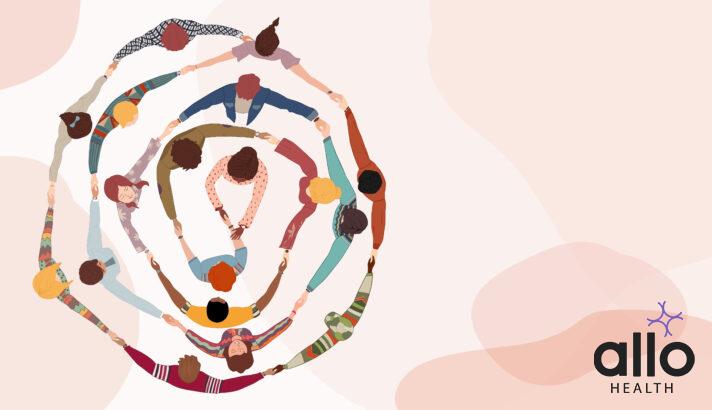Understanding Closure in Relationships: What It Is and How to Achieve It

Allo Health is dedicated to personalized well-being, offering support and trusted information tailored to individual health goals. The platform emphasizes human-generated content, led by a distinguished medical team of experts, including physicians and sexual health specialists. Their commitment to credibility involves rigorous fact-checking, authoritative research, and continuous updates to ensure accurate, up-to-date information. Allo Health's unique approach goes beyond conventional platforms, providing expert-led insights and a continuous commitment to excellence, with user feedback playing a crucial role in shaping the platform's authoritative voice.

Dr. Aditi completed her undergraduate medical education at AJIMS, Mangalore, after which she worked in multi-speciality hospitals with COVID patients and in the Pain and Palliative medicine department. Driven by her experiences, she developed a keen interest in psychiatry. Dr. Aditi believes that mental health is just as, if not more important, than physical health.
Why This Was Upated?
Our experts continually monitor the health and wellness space, and we update our articles when new information became available.
Updated on 25 February, 2024
- Article was updated as part of our commitment to diversity, equity, and inclusion.

"The following blog article provides general information and insights on various topics. However, it is important to note that the information presented is not intended as professional advice in any specific field or area. The content of this blog is for general educational and informational purposes only.
Book consultation
The content should not be interpreted as endorsement, recommendation, or guarantee of any product, service, or information mentioned. Readers are solely responsible for the decisions and actions they take based on the information provided in this blog. It is essential to exercise individual judgment, critical thinking, and personal responsibility when applying or implementing any information or suggestions discussed in the blog."
When a relationship comes to an end, it can be a painful and confusing experience for both parties involved. One of the most important steps in moving on from a relationship is achieving closure. But what exactly what is closure in relationships, and how can you achieve it?
The Importance of Closure in Relationships
Closure plays a significant role in relationships as it provides a sense of resolution, understanding, and emotional completion. It allows individuals to move forward and heal from the pain, confusion, or uncertainty associated with the end of a relationship or a significant event within a relationship. The importance of closure can be explored in several aspects:
- Emotional Healing: Closure facilitates emotional healing by helping individuals process and come to terms with their emotions. It allows them to acknowledge their feelings of loss, sadness, anger, or betrayal, and work through them in a healthy and constructive manner. Without closure, these emotions can linger and hinder personal growth and future relationships.
- Acceptance and Understanding: Closure provides the opportunity to gain a deeper understanding of the relationship dynamics, contributing factors, and reasons behind its end. It helps individuals make sense of what happened, accept the reality of the situation, and find closure in knowing that they have explored all possibilities for reconciliation or resolution.
- Moving Forward: Closure allows individuals to move forward with their lives. It gives them the necessary psychological closure to let go of the past and embrace new beginnings. By closing one chapter, individuals can open themselves up to new experiences, personal growth, and future relationships without being burdened by unresolved emotions or lingering attachments.
- Communication and Resolution: In many cases, closure involves communication between the parties involved. It provides an opportunity for honest and open dialogue, allowing both individuals to express their thoughts, feelings, and perspectives. This communication can lead to mutual understanding, forgiveness, and the resolution of any unfinished business, which can be instrumental in finding closure.
- Self-Reflection and Growth: Closure encourages self-reflection and introspection. It allows individuals to evaluate their own role in the relationship, identify areas for personal growth, and learn from past experiences. By gaining closure, individuals can become more self-aware, make positive changes, and avoid repeating patterns or mistakes in future relationships.
- Peace of Mind: Closure brings a sense of peace and closure to the mind. It helps individuals find resolution and stop obsessing over unanswered questions, “what-ifs,” or lingering doubts. This peace of mind allows them to focus on the present and future, rather than being consumed by the past.
Closure does not necessarily require direct communication with the other person involved in the relationship. Closure can be achieved through personal reflection, therapy, journaling, or other means of self-exploration. The key is to find a sense of resolution, understanding, and acceptance that allows individuals to move forward with their lives in a healthy and empowered manner.
The Definition of Closure and Its Different Types
Closure refers to the property or concept in various disciplines that describes the behavior or characteristics of a system or set of elements. It is the quality of being complete, self-contained, or having no external dependencies. Closure can have different meanings and applications across various fields, including mathematics, computer science, psychology, and philosophy. Here, I will provide you with a detailed explanation of closure and its different types in these domains.
- Closure in Mathematics: In mathematics, closure refers to the property of a set or operation that guarantees that performing the operation on elements within the set will produce another element within the same set. There are three main types of closures in mathematics:
- Closure under Addition: If a set of elements is closed under addition, it means that if you add any two elements from the set, the result will also belong to the same set. For example, the set of natural numbers (0, 1, 2, 3, …) is closed under addition because if you add any two natural numbers, the sum will always be a natural number.
- Closure under Multiplication: If a set of elements is closed under multiplication, it means that if you multiply any two elements from the set, the result will also belong to the same set. For example, the set of positive integers (1, 2, 3, …) is closed under multiplication because if you multiply any two positive integers, the product will always be a positive integer.
- Closure under Subtraction: If a set of elements is closed under subtraction, it means that if you subtract any two elements from the set, the result will also belong to the same set. For example, the set of even numbers (2, 4, 6, …) is closed under subtraction because if you subtract any two even numbers, the difference will always be an even number.
- Closure in Computer Science: In computer science, closure refers to a function or procedure that has access to variables outside its local scope. It allows the function to “remember” the state of the variables when it was first created. There are two main types of closures in computer science:
-
- Lexical Closure: Also known as a static closure, it occurs when a function retains a reference to a variable from its parent scope even after the parent function has finished executing. The enclosed function can still access and modify the variables in the parent scope. This concept is commonly used in functional programming languages like JavaScript or Python.
- Dynamic Closure: Also known as a runtime closure, it occurs when a function retains a reference to a variable based on the environment in which it is executed. The enclosed function can access and modify the variables in its runtime environment, allowing for more flexibility. Dynamic closures are often used in programming languages with support for first-class functions, such as Scheme or Lisp.
- Closure in Psychology: In psychology, closure refers to the perceptual tendency to mentally complete incomplete or fragmented stimuli. The brain seeks to fill in missing information or gaps in perception to create a meaningful whole. Closure allows us to perceive objects as complete even when parts of them are missing. This principle is commonly observed in visual perception, where our brains automatically fill in missing details based on the surrounding context.
- Closure in Philosophy: In philosophy, closure is a concept related to knowledge and belief. Epistemic closure refers to the idea that if a person knows or believes one proposition (statement) and knows or believes another proposition that logically follows from the first one, they should also know or believe the conclusion. It is based on the principle of deductive reasoning and the idea that knowledge and beliefs should be consistent and coherent.
These are some of the main definitions and types of closure in different fields. While the concept of closure may have slight variations depending on the context, the overarching idea is that closure represents completeness, self-containment, or the ability to derive new elements or conclusions within a particular system or framework.
Why Some Relationships End Without Closure
There are several reasons why some relationships end without closure. These factors can vary depending on the specific circumstances and dynamics of the relationship, but here are some common reasons:
- Communication Breakdown: A lack of effective communication is one of the primary reasons why relationships end without closure. When partners struggle to openly express their thoughts, feelings, and concerns, it can lead to misunderstandings, unresolved conflicts, and a sense of emotional distance. Without clear communication, it becomes difficult to reach a mutual understanding or achieve closure when the relationship comes to an end.
- Sudden or Unexpected Endings: In some cases, relationships can come to an abrupt or unexpected end, leaving both parties shocked and without closure. This can occur due to sudden life events, external circumstances, or one partner’s decision to end the relationship without prior warning or discussion. The suddenness of the breakup can leave individuals with unanswered questions and a sense of confusion, making it challenging to find closure.
- Avoidance of Difficult Conversations: Ending a relationship can be emotionally challenging, and some individuals may avoid having difficult conversations or addressing the concerns that led to the breakup. This can be driven by a fear of confrontation, a desire to avoid hurting the other person, or a lack of emotional maturity to handle the situation effectively. Without open and honest discussions, closure becomes elusive, and unresolved emotions can linger.
- Power Imbalance: Relationships characterized by a power imbalance, such as an unhealthy dynamic or abuse, often end without closure. The party exerting control may prevent the other person from expressing their feelings or asserting their needs, making it nearly impossible to achieve closure. In such cases, the focus is on escaping the relationship rather than seeking resolution or closure.
- Unresolved concerns and Unmet Expectations: When a relationship ends without addressing unresolved concerns or unmet expectations, closure becomes difficult to attain. These concerns may include betrayal, trust concerns , infidelity, or a lack of fulfillment in the relationship. If these concerns are left unaddressed, it can lead to a buildup of resentment and unresolved emotions, hindering the closure process.
- Emotional Avoidance: Some individuals may have a tendency to avoid or suppress their emotions, which can contribute to the lack of closure in a relationship. They may choose to detach themselves emotionally or distract themselves from the pain of the breakup. This emotional avoidance can prevent individuals from acknowledging their feelings, processing them, and actively seeking closure.
Closure may not always be possible or necessary in certain situations, especially if it poses a threat to one’s well-being or safety. In such cases, it is crucial to prioritize self-care and seek support from trusted friends, family, or professionals to navigate the healing process.
How to Recognize When You Need Closure in a Relationship
Recognizing the need for closure in a relationship is an important step towards emotional healing and moving forward. Here are some key signs that indicate you may need closure:
- Lingering Emotions: If you find yourself still experiencing intense emotions related to the ended relationship, such as sadness, anger, resentment, or confusion, it suggests a need for closure. These emotions may resurface frequently, impacting your overall well-being and hindering your ability to fully engage in new experiences or relationships.
- Intrusive Thoughts and Rumination: Constantly thinking about the relationship, replaying memories, or obsessing over unanswered questions signifies a need for closure. If your mind is preoccupied with thoughts about the past and what could have been, it indicates unresolved feelings and a longing for closure.
- Unresolved concerns and Unfinished Business: If there are unresolved concerns or unaddressed concerns from the relationship, you may feel a need for closure. It could include unexpressed feelings, unresolved conflicts, or lingering questions about the circumstances surrounding the breakup. These unresolved matters can create a sense of incompleteness, making closure necessary for moving forward.
- Difficulty Letting Go: If you find it challenging to let go of the relationship or still hold onto hope for reconciliation, it suggests a need for closure. Inability to accept the end of the relationship and move forward can keep you emotionally attached to the past, preventing you from embracing new possibilities and experiences.
- Seeking Validation or Closure from the Other Person: If you feel a strong desire to seek validation or closure from your ex-partner, it may indicate a need for closure. You may have unanswered questions or a longing for their acknowledgment or apology. Seeking closure from the other person, however, should be approached with caution as it may not always be possible or beneficial.
- Stagnation in Personal Growth: When a lack of closure hinders your personal growth and development, it signals a need to address the unresolved aspects of the relationship. If you find yourself stuck in patterns of behavior or unable to move forward in other areas of your life, achieving closure can provide the necessary emotional release to promote personal growth.
- Repeated Relationship Patterns: If you notice a pattern of entering into similar relationships or encountering similar challenges in subsequent relationships, it could indicate a need for closure from past experiences. Unresolved concerns from previous relationships can unconsciously influence future relationships, making it important to address and find closure in order to break these patterns.
Recognizing the need for closure is the first step, but it’s equally important to take appropriate actions to seek closure. This may involve self-reflection, seeking support from friends or professionals, engaging in therapy, or engaging in activities that promote emotional healing and personal growth. Remember that closure is a personal process, and it may take time and effort to achieve, but it can significantly contribute to your overall well-being and ability to move forward in a healthy way.
Techniques for Achieving Closure in a Relationship
Achieving closure in a relationship is a personal process that can vary from individual to individual. Here are some techniques that can help facilitate the closure process:
- Reflect and Accept: Take time to reflect on the relationship and the reasons for its end. Engage in honest self-reflection to identify your own contributions and areas for personal growth. Acceptance of the reality of the situation is crucial for achieving closure. Recognize that the relationship has come to an end and that it is essential to move forward.
- Express Your Feelings: It’s important to express your feelings and emotions related to the relationship. Write a letter to your ex-partner, even if you don’t intend to send it, to release your thoughts and emotions. Alternatively, consider talking to a trusted friend, family member, or therapist about your feelings. Expressing your emotions can provide a sense of relief and aid in the closure process.
- Seek Clarification: If there are unanswered questions or unresolved concerns, it may be helpful to seek clarification. This can involve having an open and honest conversation with your ex-partner, if appropriate and safe to do so. Communicate your concerns and seek their perspective, but be prepared for the possibility that you may not receive the answers you are looking for. Remember that closure ultimately comes from within yourself, not from external sources.
- Set Boundaries: Establishing clear boundaries with your ex-partner can support the closure process. Limit or eliminate contact for a period of time to create space for healing. This includes refraining from checking their social media profiles, avoiding places or activities that remind you of them, and giving yourself the necessary distance to focus on your own well-being.
- Engage in Self-Care: Prioritize self-care activities that promote healing and well-being. This can include engaging in physical exercise, practicing mindfulness or meditation, seeking therapy or counseling, spending time with supportive friends and family, and pursuing hobbies or activities that bring you joy. Taking care of yourself is essential during the closure process.
- Focus on Personal Growth: Use the opportunity to focus on your personal growth and development. Set new goals, explore new interests, and invest time and energy into self-improvement. By channeling your energy into positive endeavors, you can shift your focus away from the past and towards a brighter future.
- Let Go and Forgive: Release any resentment or negative emotions towards your ex-partner. Forgiveness does not mean condoning their actions but rather freeing yourself from the emotional burden of holding onto grudges. Letting go of the past allows you to move forward with a lighter heart and a clearer mind.
- Surround Yourself with Support: Seek support from friends, family, or a therapist who can provide a listening ear, guidance, and validation. Sharing your experiences and emotions with others who care about your well-being can be incredibly beneficial in the closure process.
Remember that achieving closure takes time and effort. Be patient with yourself and allow yourself to experience the range of emotions that may arise during the process. Each person’s journey to closure is unique, and it’s essential to honor your own pace and needs.
Common Misconceptions About Achieving Closure in Relationships
Achieving closure in relationships is a complex and individual process, and there are several misconceptions that can cloud our understanding of it. Here are some common misconceptions about achieving closure:
- Closure Means Complete Resolution: One misconception is that achieving closure means tying up all loose ends and finding a perfect resolution to all concerns. In reality, closure is more about finding emotional resolution within yourself rather than obtaining all the answers or getting the other person’s validation or apology. It’s about reaching a point where you can accept the reality of the situation and move forward, even if there are still unanswered questions or unresolved aspects.
- Closure Requires the Other Person’s Participation: Closure is often seen as something that can only be achieved with the involvement and cooperation of the other person. While it can be helpful to have open and honest communication with your ex-partner, closure is ultimately an individual process. It’s about finding inner peace and healing within yourself, regardless of whether the other person is willing or able to provide closure.
- Closure Happens Quickly: Another misconception is that closure is something that can be achieved quickly or on a specific timeline. In reality, closure is a personal and ongoing process that takes time. It can vary greatly from person to person, depending on the nature of the relationship, the depth of emotions involved, and individual coping mechanisms. It’s important to be patient with yourself and allow the closure process to unfold naturally.
- Closure Means Forgetting or Erasing the Past: Closure is not about erasing the past or forgetting about the relationship entirely. It’s about finding a way to make peace with the past and integrate it into your personal growth and understanding of yourself. The experiences and lessons from the relationship can still hold value and shape your future, even after achieving closure.
- Closure Guarantees Future Happiness: Some people mistakenly believe that achieving closure automatically leads to immediate happiness and the ability to move on effortlessly. While closure is an important step in the healing process, it doesn’t guarantee instant happiness or the absence of future challenges. Healing takes time, and it’s normal to experience ups and downs along the way. Closure provides a foundation for moving forward, but it’s still necessary to invest in self-care, personal growth, and building new relationships.
- Closure is a Linear Process: Closure is often seen as a linear progression, where you go through a series of steps and then reach a definitive endpoint. However, the closure process is more fluid and non-linear. It involves navigating through various emotions, revisiting certain aspects, and making progress at your own pace. It’s important to allow yourself the flexibility to move forward while acknowledging that closure can be an ongoing journey.
It’s essential to recognize that achieving closure is a personal and subjective experience. Each individual may have different needs, timelines, and ways of finding closure. It’s important to honor your own process and seek support from trusted friends, family, or professionals if needed.
The Role of Time and Healing After a Breakup
The end of a romantic relationship, commonly known as a breakup, can be a challenging and emotionally turbulent experience. Time and healing play crucial roles in the process of recovering and moving forward after a breakup. Let’s delve into the details of these aspects:
- Time as a Facilitator of Healing: Time is often considered a natural healer when it comes to emotional wounds. It provides an opportunity for individuals to gradually process their emotions, reflect on the relationship, and gain perspective. While there is no fixed timeline for healing, the passage of time allows one to adjust to the new reality, adapt to life without the former partner, and find ways to rebuild a sense of self.
- Emotional Processing: Healing after a breakup involves navigating a wide range of emotions such as sadness, anger, betrayal, confusion, and even relief. These emotions may surface immediately after the breakup or may emerge over time. It is essential to give oneself permission to feel these emotions fully, rather than suppressing or avoiding them. By acknowledging and processing these emotions, individuals can gradually release their grip on the past and create space for emotional healing.
- Self-Reflection and Growth: Time post-breakup also allows individuals to engage in self-reflection and introspection. It’s an opportunity to evaluate the dynamics of the relationship, identify patterns, and gain insights into oneself and personal needs. Self-reflection can foster personal growth and provide valuable lessons for future relationships. It involves examining one’s contributions to the relationship, recognizing areas for improvement, and developing a deeper understanding of personal values and boundaries.
- Rebuilding Self-Identity and Self-Esteem: Breakups can often leave individuals feeling a loss of identity, as they may have invested significant time and energy into the relationship. Healing requires focusing on rebuilding a sense of self and reclaiming individuality. This involves reconnecting with personal interests, hobbies, and goals that may have been neglected during the relationship. Engaging in activities that bring joy and a sense of accomplishment can help boost self-esteem and foster a positive self-image.
- Social Support: Time and healing can be greatly facilitated through the support of family, friends, or a professional network. Sharing feelings and experiences with loved ones can provide comfort, validation, and a sense of belonging. Seeking guidance from a therapist or counselor can offer an objective perspective and tools for healing. Engaging in support groups or online communities with individuals going through similar experiences can also be beneficial.
- Establishing Boundaries: Healing after a breakup involves setting and maintaining healthy boundaries. This includes defining what is acceptable and not acceptable in future relationships, as well as establishing boundaries with the former partner. Clear boundaries help create emotional safety and provide a framework for moving forward with clarity and self-respect.
- Rediscovering Trust and Opening up to New Relationships: Healing from a breakup often entails rebuilding trust in oneself and others. Time allows for a gradual process of healing the wounds caused by the previous relationship, learning from past experiences, and developing a more discerning approach to future relationships. While it’s important to give oneself time to heal fully before entering a new relationship, eventually, the healing process can lead to a renewed sense of openness and readiness for new connections.
The healing process is unique to each individual, and there is no one-size-fits-all approach. While time is a crucial element in the healing journey, actively engaging in self-care, seeking support, and practicing self-compassion can accelerate the process and promote a healthier emotional state after a breakup.
When to Seek Professional Help with Achieving Closure
Seeking professional help can be beneficial for achieving closure after a breakup when individuals find it difficult to navigate the healing process on their own. Here are some specific situations in which seeking professional assistance can be valuable:
- Prolonged Emotional Distress: If the emotional distress and pain caused by the breakup persist for an extended period, it may be a sign that professional help is needed. Feeling constantly overwhelmed, experiencing intense sadness or anger, and being unable to function in daily life are indicators that additional support may be necessary.
- Intrusive Thoughts and Obsessions: Persistent thoughts about the ex-partner, constant rumination about the relationship, and a preoccupation with the breakup can hinder the healing process. If intrusive thoughts and obsessions are interfering with daily functioning, it may be helpful to consult with a therapist who can provide guidance and techniques to manage and redirect these thoughts.
- Difficulty in Letting Go: Letting go of a past relationship can be challenging, especially if there are unresolved feelings, unfinished business, or a sense of attachment. If individuals find it exceedingly difficult to detach emotionally from their ex-partner or are stuck in a cycle of longing and yearning, a therapist can assist in exploring these feelings and working towards closure.
- Unresolved Trauma or Abuse: Breakups involving trauma, emotional abuse, or any form of violence can leave deep scars. Professional help is crucial in such cases to address the trauma, process the emotions, and develop strategies for healing. Therapists who specialize in trauma can provide a safe and supportive environment for individuals to work through their experiences and find closure.
- Impact on Daily Life and Functioning: If the aftermath of a breakup is significantly affecting various aspects of life, such as work performance, relationships with family and friends, or physical health, seeking professional help can be beneficial. A therapist can help individuals regain balance, develop coping strategies, and rebuild a sense of stability and well-being.
- Repeating Negative Patterns: If individuals find themselves repeatedly experiencing similar patterns in their relationships, such as attracting toxic partners or engaging in destructive behaviors, it may be indicative of underlying concerns that require professional intervention. Therapy can help identify and address these patterns, promote self-awareness, and facilitate personal growth to break the cycle.
- Difficulty in Rebuilding Trust: Breakups can shake one’s trust in oneself and others. If individuals find it challenging to trust again, whether in future relationships or in their own judgment, therapy can provide a supportive environment to explore and rebuild trust. A therapist can guide individuals through the process of developing healthier relationship patterns and cultivating self-trust.
Seeking professional help is not a sign of weakness but rather a proactive step towards personal growth and healing. Therapists and counselors are trained to provide guidance, support, and evidence-based techniques to help individuals navigate the complexities of closure and move forward in a healthy and empowered way.
Understanding the Connection Between Forgiveness and Closure
Forgiveness and closure are interconnected and can have a significant impact on the healing process after a breakup or any form of emotional hurt. Here’s a detailed explanation of the connection between forgiveness and closure:
- Definition of Forgiveness: Forgiveness involves the intentional and voluntary process of letting go of resentment, anger, and the desire for revenge towards the person who has caused emotional pain. It is not about condoning or forgetting the actions that caused the hurt but about releasing oneself from the negative emotions associated with the past.
- Closure as an Outcome of Forgiveness: Closure is often seen as a state of resolution, acceptance, and emotional completion regarding the end of a relationship. When individuals engage in forgiveness, it can facilitate the process of closure by helping them move beyond the pain, grievances, and emotional attachments associated with the breakup. Forgiveness allows individuals to release the emotional baggage and find a sense of resolution within themselves.
- Letting Go of Negative Emotions: Both forgiveness and closure involve letting go of negative emotions such as anger, resentment, and bitterness. Holding onto these emotions can prolong the healing process and prevent individuals from moving forward. Forgiveness allows individuals to acknowledge their emotions, process them, and ultimately release them, paving the way for closure.
- Releasing the Need for Justice or Revenge: Forgiveness involves relinquishing the desire for justice or revenge against the person who caused the pain. It frees individuals from the burden of seeking retribution and redirects their focus towards personal growth and healing. By letting go of the need for justice or revenge, individuals create space for closure and can redirect their energy towards their own well-being.
- Rebuilding Trust and Reestablishing Boundaries: Forgiveness is often a necessary step in rebuilding trust, both in oneself and in others. It involves recognizing that not everyone will hurt or betray in the same way and opening oneself up to the possibility of new healthy relationships. By forgiving, individuals can establish clearer boundaries and make more informed decisions in future relationships, contributing to a sense of closure and emotional safety.
- Self-Compassion and Self-Healing: Forgiveness is a compassionate act towards oneself as well. It allows individuals to extend understanding and compassion to their own emotions, mistakes, and vulnerabilities. By forgiving oneself for any perceived shortcomings or mistakes made during the relationship, individuals can cultivate self-acceptance and self-healing, ultimately facilitating closure.
- Reshaping the Narrative and Finding Meaning: Forgiveness can help individuals reshape the narrative of the breakup or emotional hurt. It involves reframing the experience from a victim-centered perspective to one of personal growth and resilience. By finding meaning in the pain and learning from the experience, individuals can reach a sense of closure and move forward with a renewed sense of purpose.
- Continued Growth and Healing: Forgiveness and closure are ongoing processes that require time and self-reflection. It is important to recognize that forgiveness does not necessarily mean reconciliation or forgetting the past entirely. It is a personal journey that allows individuals to let go of the emotional weight and create space for continued growth and healing.
While forgiveness and closure are interconnected, it’s important to note that forgiveness is a personal choice and may not be necessary or appropriate in all circumstances. The journey towards forgiveness and closure is unique to each individual, and it’s essential to honor one’s own emotions and needs throughout the process. Seeking support from a therapist or counselor can be beneficial in navigating these complex emotions and facilitating forgiveness and closure.
How to Avoid Reopening Old Wounds After Achieving Closure

Achieving closure after a breakup or any emotional hurt is a significant milestone in the healing process. However, it’s important to take proactive steps to avoid reopening old wounds and maintain the sense of closure. Here are some strategies to help you avoid reopening old wounds:
- Establish Boundaries: Setting clear boundaries with your ex-partner or anyone associated with the past can help prevent unnecessary contact or reengagement. Communicate your boundaries assertively and stick to them. This includes limiting or cutting off contact, avoiding social media stalking, and refraining from discussing the past with mutual acquaintances.
- Focus on the Present: Shift your focus to the present moment and the future. Engage in activities, hobbies, and goals that bring you joy and fulfillment. Stay connected with supportive friends, pursue personal growth, and invest your energy in positive experiences and relationships. By focusing on the present, you create momentum for moving forward and prevent dwelling on the past.
- Practice Self-Care: Prioritize self-care to maintain your emotional well-being. Take care of your physical health, engage in activities that reduce stress, practice mindfulness or meditation, and ensure you get enough rest and relaxation. Self-care strengthens your resilience and helps you stay grounded in the present moment, reducing the chances of reopening old wounds.
- Challenge Negative Thoughts: Be aware of negative thoughts that may arise, such as dwelling on past memories, blaming yourself or the other person, or engaging in self-criticism. When negative thoughts emerge, consciously challenge them by reframing them in a more positive or realistic light. Practice self-compassion and remind yourself of the progress you have made in achieving closure.
- Learn from the Experience: Reflect on the lessons you have learned from the past relationship or emotional hurt. Identify patterns or behaviors that you want to avoid in future relationships. Use the experience as an opportunity for personal growth and self-improvement. By focusing on the lessons learned, you can channel your energy towards creating a better future rather than reopening old wounds.
- Engage in Emotional Processing: Emotions may resurface from time to time even after achieving closure. It’s important to allow yourself to feel these emotions and process them in a healthy way. Journaling, talking to a trusted friend or therapist, or engaging in creative outlets such as art or music can help you process and release any lingering emotions without reopening old wounds.
- Practice Mindfulness: Cultivate mindfulness by staying present and aware of your thoughts, emotions, and bodily sensations. When you notice yourself dwelling on the past or getting caught up in old wounds, gently bring your focus back to the present moment. Mindfulness helps you detach from the past and prevents the reopening of old wounds.
- Seek Professional Support if Needed: If you find yourself consistently struggling to avoid reopening old wounds or if the emotions become overwhelming, consider seeking professional support. A therapist or counselor can provide guidance, tools, and techniques to help you navigate any lingering emotional challenges and maintain your sense of closure.
Achieving closure in a relationship is an essential step towards emotional healing and growth. It’s important to understand the definition and various types of closure, as well as the psychological benefits of achieving it. If you’re struggling to achieve closure in a relationship, try using the techniques we’ve outlined, and consider seeking professional help or counseling if necessary. Remember that moving on and achieving closure take time, effort, and patience, but with the right mindset and support, it’s possible to achieve closure and move forward with a positive outlook on the future.







































